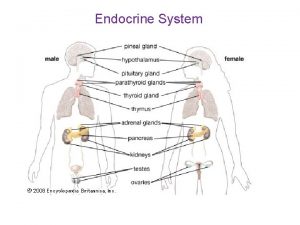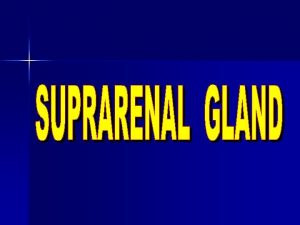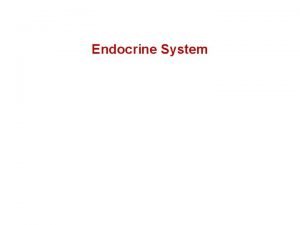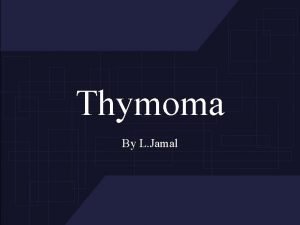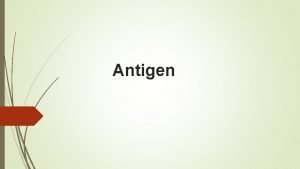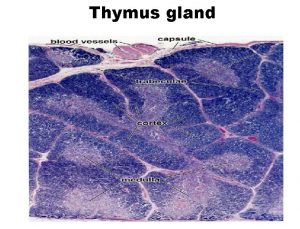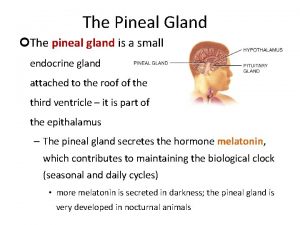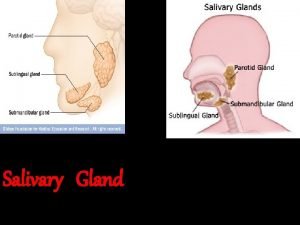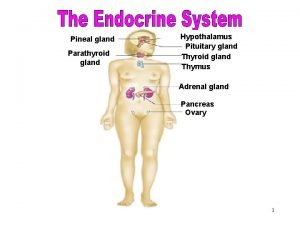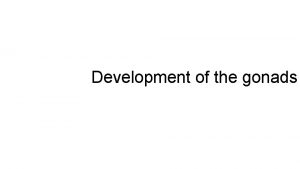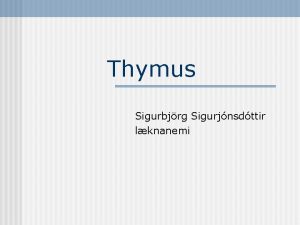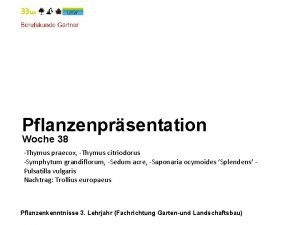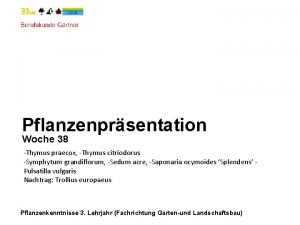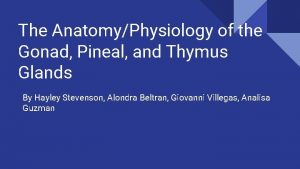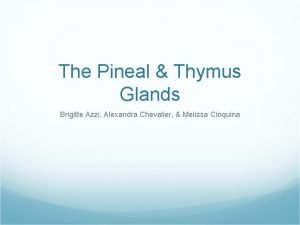Gonads Pineal Gland Thymus Pineal Gland Location Deep


















- Slides: 18

Gonads, Pineal Gland, Thymus

Pineal Gland Location: Deep in the center of the brain Basic Anatomy: a small pine-cone shaped mass of glandular tissue about ⅓ of an inch (8 mm long) Consists of astrocytes and pinealocytes surrounded by a layer of pia mater Pia mater consists of many blood vessels that support underlying tissues Astrocytes support pinealocytes within the pineal gland.

Pineal Gland General Function: The pineal gland produces melatonin from the pinealocytes to flow through the bloodstream

Abnormalities with Pineal Gland + Secretions Symptomatic pineal cysts: common, fluid-filled sacs; larger cysts are very rare and produce headaches Hydrocephalus: condition marked by increased pressure on the brain because of the accumulation of excessive cerebrospinal fluid in the skull Secretions: Melatonin: helps control your sleep and wake cycles; regulates reproductive hormones

Thymus Gland Location: Behind your sternum and between your lungs Basic Anatomy: A soft, roughly triangular organ include thymic cells like lymphocytes, epithelial cells, and Kulchitsky cells ( neuroendocrine cells) epithelial tissues and lymphatic tissues containing dendritic cells and macrophages make up the majority of both regions of the thymus two distinct but identical lobes surrounded by a tough, fibrous capsule within each lobe is the cortex and a distinct deep region called the medulla

Thymus Gland General Function: 1. Epithelial Cells- Give shape and structure to the thymus 2. Lymphocytes- immune cells; protect against infection and stimulate immune responses 3. Kulchitsky cells- hormone-releasing cells Receives immature T cells that are produced in the red bone marrow Trains them into functional, mature T cells that attack only foreign cells T cells recognize antigens and help fight infections

Thymus Diesase or Abnormalites Thymoma tumor of the Thymus about 30 - 65% of people with Thymomas also have myastenia gravis Myastenia Gravis - is the most common autoimmune disease associated with thymoma SCID or Severe Combined Immunodeficiency develops when a person carries a mutation in a gene that regulates development of T Cells

Thymus Secretions Thymosin: a hormone necessary for T cell development and production; stimulates T cell production

Gonads (Testes-Male Gonads) Location: They are located within the scrotum. Basic Anatomy: a pair of ovoid glandular organs that are central to the male reproductive system each testis is about 1. 5 to 2 inches long and around 1 inch in diamater located inside a scrotal cavity & covered by a layer of connective tissue known as the tunica albuginea each testis divided into several 100 small segments called lobules Lobules contain the seminiferous tubules, which contain germ cells, sertoli cells, and leydig cells that give the testes their function

Gonads (Testes) Epididymis- collects mature sperm and propel through vas deferens Vas deferens- tube where sperm leave to the outside of the body General Function: Testes are responsible for the production of sperm cells and the male sex hormone testosterone

Disease or Abnormalities (Male) Hypogonadism - a result of low testosterone If not enough testosterone is produced it could affect masculine growth and development during puberty. Symptoms - loss of body hair - Muscle loss - Fertility - Fatigue

Testes Secretions Testosterone: develops male reproductive tissues and promotes secondary sexual characteristics like increased muscle and body hair

Gonads (Ovaries-Female Gonads) Location: on opposite ends of the pelvic wall, on either side of the uterus. They are attached to the fimbria. Basic Anatomy: Paired organs located on the sides of the uterus small, oval-shaped and grayish in color, with an uneven surface size depends on a woman’s age and hormonal status-- vary 3 -5 cm in childbirthing years 3 Components: Surface: formed by simple cuboidal epithelium Cortex: comprised of connective tissue stroma; supports thousands of follicles

Gonads (Female) Two peritoneal ligaments attach to the ovary: suspensory ligament of ovary: extends from mesovarium to the pelvic wall; contains neurovascular structures ligament of ovary: extends from ovary to fundus of the uterus General Function: Produce oocytes in preparation for fertilization produce sex steroid hormones oestrogen and progesterone

Disease or Abnormalities (Female) Hypogonadism - causes imbalances in estrogen and progesterone Symptoms - lack of menstruation - Slow or absent breast growth - Hot flashes - Loss of body hair - Low or absent sex drive

Ovary Secretions Estrogen: responsible for the growth and development of female sexual characteristics and reproduction in humans; prepares for menstruation Progesterone: prepares the body for pregnancy by causing the uterine lining to thicken; also prepares for menstruation Inhibin: signals to the pituitary to inhibit follicle-stimulating hormone secretion

Works Cited Page Allhumanatomy. com anatomy-medicine. com Endocrineweb. com Ovaries: http: //emedicine. medscape. com/article/1949171 -overview#a 1 http: //teachmeanatomy. info/pelvis/female-reproductive-tract/ovaries/ Oxfordbucksurology. com Testes: https: //www. innerbody. com/image_endoov/repo 10 -new 2. html Theheartysoul. com

Works Cited Page Pineal Gland: https: //www. innerbody. com/image_nerv 02/nerv 64 -new. html Thymus Gland: https: //www. innerbody. com/image_endoov/lymp 04 -new. html www. endocrineweb. com/endocrinology/overview-pineal-gland www. endocrineweb. com/endocrinology/overview-thymus www. endocrineweb. com/endocrinology/overview-testes www. endocrineweb. com/endocrinology/overview-ovaries
 Pituitary gland and pineal gland spiritual
Pituitary gland and pineal gland spiritual Thyoid gland
Thyoid gland Thymus location
Thymus location Izlədiyiniz üçün təşəkkürlər
Izlədiyiniz üçün təşəkkürlər Thymus gland
Thymus gland Seat of the soul pineal gland
Seat of the soul pineal gland Pineal gland secretes
Pineal gland secretes Parafollicular cells vs follicular cells
Parafollicular cells vs follicular cells Secretin target organ
Secretin target organ Coupe histologique du thymus
Coupe histologique du thymus Hypogammaglobulenemia
Hypogammaglobulenemia Thymus serpilum
Thymus serpilum Thymus immune system
Thymus immune system Thymus galnd
Thymus galnd Thymus independent antigens
Thymus independent antigens Thymus independent antigens
Thymus independent antigens O the deep deep love of jesus
O the deep deep love of jesus Deep asleep deep asleep it lies
Deep asleep deep asleep it lies Deep forest: towards an alternative to deep neural networks
Deep forest: towards an alternative to deep neural networks


